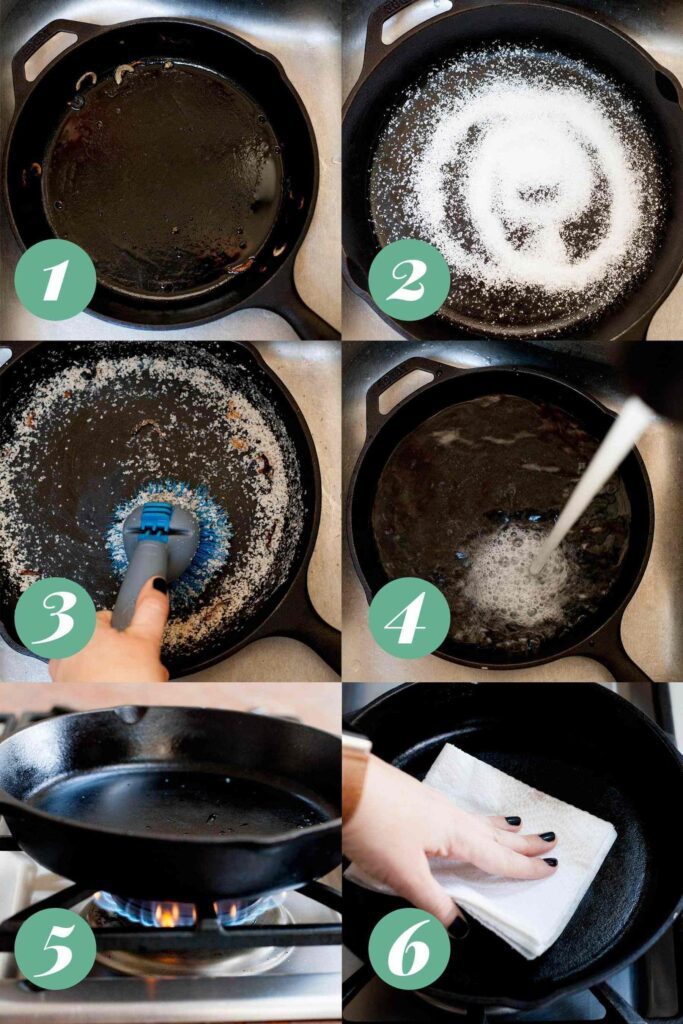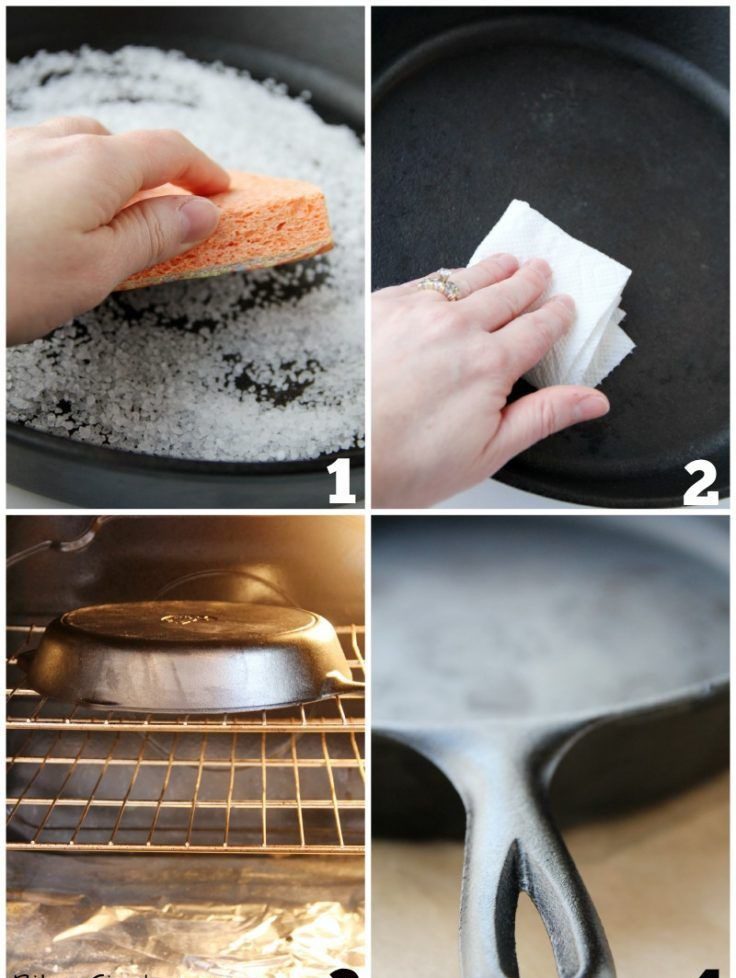Step-By-Step Methods of Cleaning Cast Iron Skillets And Cookware
Daniel Gritzer, Senior Culinary Director for Serious Eats writes:
Soap is good at washing away grease and dirt, so perhaps it’s understandable that people think it can also wash away seasoning, since the seasoning is essentially baked-on fat. But even though the seasoning started out as a fat, it’s been so thoroughly transformed (“polymerized” is the technical word) that it’s no longer at risk of being stripped away by a bit of soap, especially not the gentle modern soaps we work with today.
No, if you wanted to remove the seasoning, you’d need to either scour it with something very abrasive, like steel wool; heat it at a very high temperature for an extended period without any fat in it; soak it in a strong lye solution; or strip it via electrolysis. Suffice it to say, it takes quite a bit of effort to take the seasoning off a cast iron pan.

Step 1 & 2: Wash the Cast Iron Pan Well
Once you’re done cooking in your pan, go ahead and wash it with some warm soapy water, wiping it with a kitchen sponge. If there are a few stubborn burnt-on bits, you’ll be fine using the synthetic scrubber on the back of many kitchen sponges, as it’s not as harsh as steel wool.
If, for some reason, you’ve scorched some nasty stuff into the pan, you can pour salt into it, set it over high heat, then rub the charred gunk out with some paper towels. The salt acts as an abrasive that’s safe for the seasoning, while the heat can help carbonize any remaining bits of food, making them easier to scrub away. Then just rinse out the salt, wash the pan with warm soapy water, and continue to the next step.
Step 3 & 4: Dry the Cast Iron Pan Thoroughly
Water is the enemy of cast iron, so the last thing you want to do is leave it dripping wet post-wash. Sure, the seasoning will prevent any rust from forming right away, but if the pan is left to stand with water in it, even those tough layers of polymerized oil won’t be enough to stop the relentless oxidative skirmish between iron and H2O.
So make sure to dry the pan thoroughly with towels right after washing. Even better, once you’ve hand-dried the pan as best you can, set it over a high flame. The heat will speed evaporation, driving off any last bit of moisture and guaranteeing that the pan is totally dry.
Step 5 & 6: Oil Lightly and Heat the Cast Iron Pan
The last step is to prime the pan for its next use by laying down one bonus layer of protective seasoning before putting it away. To do that, just rub the pan very lightly all over with an unsaturated cooking fat, like canola, vegetable, or corn oil, making sure to buff away any visible greasiness so that the cast iron almost doesn’t look like you’ve oiled it at all.
Then put the pan back over a burner set to high heat, and leave it for a couple of minutes, until the pan is heated through all over and lightly smoking. You could do this in your oven for more even heating, à la the initial seasoning process, but I find that too cumbersome as part of a daily ritual; for just one quick final seasoning step, the stovetop works fine. (Note that if you rub the pan with oil and put it away without heating it, the oil can become sticky and rancid before the pan’s next use, which is a real bummer. If you’ve accidentally let this happen, just wash out the pan with soap and water to get rid of the gunk, then dry it and heat it, and you should be good to go.)
Excerpted from “How to Clean and Care for Cast Iron Cookware” by Daniel Gritzer…. Copyright 2019 seriouseats.com
Tiffany La Forge, owner of Parsnips and Pastries and author of The Modern Cast Iron Cookbook writes on how you clean a cast iron skillet:

While the pan is still warm (but not hot!), use mild dish soap or salt to clean the pan.
- To get rid of the stuck-on pieces, use a pan scraper, a non-abrasive sponge, a stiff-bristled nylon brush, or a chainmail scrubber.
- If the bits still aren’t coming off, bring water to a boil in the pan so the food loosens.
- Once everything is clean, immediately dry it.
Using a paper towel, rub in cooking oil evenly over the pan. If your cast iron skillet looks particularly dull or food is getting stuck more often, you’ll want to re-season it with these steps:
- Coat the entire surface of the pan (even the exterior) with a thin layer of cooking oil that’s been thoroughly and evenly rubbed in.
- Place the oiled pan in a cold oven upside-down with foil below it to catch any drippings.
- Turn the oven to 400°F.
- When it reaches that temperature, bake the pan for one hour.
- At the one-hour mark, turn the oven off and let the pan cool in the oven.
- You can repeat this process a few times to develop a resilient seasoning, but you don’t have to.
Excerpted from “How to Clean and Season a Cast Iron Skillet, According To A Chef” by Georgia Davis …. Copyright 2022 womenshealthmag.com









